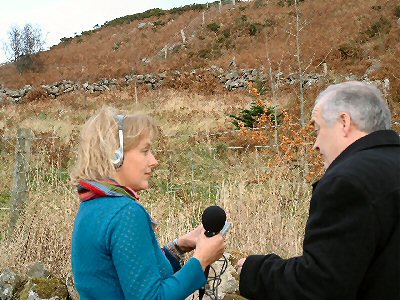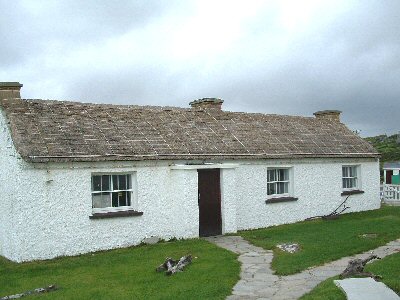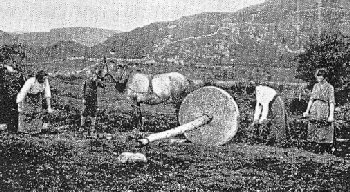History
Egyptian Arch
St John of God Centenary
UnChristian Guardians 1860
Fields of Grace
Kate’s Going to Yankeeland
Ballagh Millstone
On the edge of the Calliagh Berra’s lake on the top of Slieve Gullion is a massive millstone, clearly recognizable in the photo from its circular shape and the hole in the middle. I’ll tell you the story and it’s the God’s truth, for indeed any other attempted explanation would be preposterous.
There was a time when the milling of corn was one of the chief, and indeed the most lucrative enterprises in the country. People have to eat, don’t they, whether in war or in peace? And the owner who has the hardest, and most long-lasting and largest millstone, capable of grinding the greatest quantity of wheat in the shortest space of time and over an extended period of many years, clearly would have the advantage over his rivals.
There was a mill in the Ballagh district one time in need of a new millstone and the owner, one Peter O’Mara was determined to outshine his rivals. He knew that the granite stones that made up the stone-age passage grave on top of Slieve Gullion could not be beaten for their hard and long-lasting qualities. He cared nothing for the customs and long-held beliefs that these graves should not, at any cost, be interfered with. In the middle of the night – for despite his callousness, he cared not to let his neighbours know the source of his new millstone – he arranged to have one of the largest and appropriately shaped granite rocks removed and transported to his mill. It took little shaping to turn it to its new purpose and in no time at all, it was grinding out meal by the ton. Peter’s mill thrived for many a day and he became rich.
But like all before him and since, that dared to interfere with things of the ancestors, bad luck plagued him thereafter. Though his mill thrived, his cattle and indeed his family did not. His cows were dropping off with all sorts of disorders and over the space of a few years he lost his wife and three of his children to strange diseases. It was an oul’ neighbour woman that suggested to him that maybe he had done something to bring the curse of the gentle people upon himself. Then he knew.
He arranged, as fast as he could to right this wrong. But it was easier for the oul’ donkey to carry his heavy load down the mountain than it was to carry it back up again. He was but two hundred metres from the passage grave, at the side of the Calliagh Berra’s lake, when he dropped down dead and the millstone landed in its present location.
But no more harm came to Peter for his intention was good.
And if you can think of a better explanation why that stone is there, well, I’d like to hear it!
Fulacht Fiadh
Frank Carroll: Missionary
Attending the Abbey Grammar in the ’60s we could look out a window to the home at 71 Castle Street, of Archbishop Francis Carroll. The Christian Brothers never tired of lauding his praises as the greatest of their past-pupils. Perhaps we were too young or sceptical then to appreciate their words. To show they were not – in the words of my old mentor, Paddy Arthur Crinion – ‘wasting their sweetness on the desert air’, I post this tribute!
Francis Carroll was born the son of Patrick and Mary Carroll and attended the Abbey Christian Brothers School in Newry. Deciding to become a priest he studied theology at Dromantine until June 1937. He was one of eighteen priests ordained by Bishop Mulhern in St Colman’s Cathedral in December 1936. Frank was to have a distinguished missionary career in Africa. Attempts to establish a mission in the Monrovia district of Liberia had met with limited success before his arrival. Liberia was (and is) an impoverished country with a dispersed population, simmering political unrest, poor communications and a virtual absence of medical facilities. The difficult climate – just a few degrees from the equator, and known as the Whiteman’s Grave – the isolation and the poverty exacted a heavy toll on members of the Irish province of the SMA.
Frank took charge of a mission composed of young and inexperienced priests. His jurisdiction on the Kru Coast was accessible only by sea and was the least developed region of that underdeveloped republic. Yet through his energetic and outgoing personality, his excellent relations with the indigenous population and with the Americo-Liberian government of President Tubman, his clear conception of what he required, his skill in obtaining funds and his exceptional ability to ‘get things done’, he succeeded in transforming the moribund coastal mission of 1951 into the thriving, vigorous mission of 1958.
Frank’s achievements when he became Bishop were no less impressive. His skills as a diplomat when he later served as apostolic delegate and Vatican representative were of inestimable value. For his lifetime’s work Frank was four times decorated by the Liberian government for outstanding services to the nation in education, health, social welfare and evangelism. It is a tragedy that the ‘country of the freed slaves’ today does not have the services of one of his qualities. Liberia unfortunately is once again one of the most afflicted countries on the African continent.
Frank Carroll’s remains lie in St Mary’s Cemetery. An obituary by a senior colleague summarized his life’s work:
‘A missionary in Liberia for forty-two years .. when Archbishop Carroll retired he was beyond question the foreigner who knew more Liberians from all walks of life and all social classes than anyone else. All this time he promoted Liberian education at every level. He took particular interest in the poor and the sick, establishing orphanages and clinics throughout the country. His door was always open not just to diplomats and government officials, but to the poor. He gave particular attention to youth. In a country where Catholics are a small minority he made the role of the Church appreciated by all. He leaves behind the memory of a man of deep faith who had a great love for the people of Liberia.’ And for the people of Newry, I might add. May he rest in peace.







